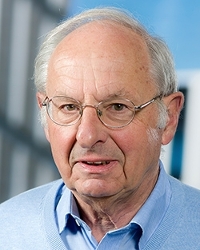Marc van Hemert
Professor emeritus of Theoretical chemistry
- Name
- Prof.dr. M.C. van Hemert
- Telephone
- +31 71 527 4244
- m.hemert@chem.leidenuniv.nl

More information about Marc van Hemert
Water has been the lead theme in my research. Initially as a solvent, later also as an important compound in itself. In the early seventies I had built a vacuum UV spectrometer to be used for the study of polymeric acids (PMA) in water as a solvent. At that time little was known about the VUV absorption behavior of water in the condensed phase, so my first goal was to figure out what was going on. It needed quantum chemistry to get the proper interpretation and it took me a while to get familiarized. It appears that my 1980 paper on the interaction between excited water molecules has become a classic paper and is now again in the picture as the first to address the VUV spectral red shift upon condensation. In the late seventies and early eighties, I concentrated on the quantum chemistry of intermolecular forces, both fully ab initio, and with the help of the electron gas method. Through intense cooperation with the theory group of the University of Bonn, I had the opportunity to further study the excited states of diatomic molecules. In particular I worked on the effects of Born-Oppenheimer breakdown in spectroscopy and photodissociation . At the end of the eighties, diatomics were sort of complete and I went into photodissocation dynamics of triatomics, triggered by the return to Leiden of Ewine van Dishoeck who was to become a professor in molecular astrophysics. Ewine also pushed me back into intermolecular forces, but now to be applied in inelastic collisions. The work done by/with our postdoc Alison Offer on OH + H2, both on intermolecular forces and on rotationally inelastic collision dynamics, is a great achievement. The photodissociation work is still on going and has profited enormously from the contributions made by Geert-Jan Kroes. Once you know something about quantum chemistry, there are always people you can help or join in their research. Therefore, over the years, I participated in many ab initio studies of somewhat larger, mostly organic, molecules. Often these molecules were in their excited states, and often spin-orbit coupling played a role.
Professor emeritus of Theoretical chemistry
- Science
- Leiden Institute of Chemistry
- LIC/Energy & Sustainability
- LIC/ES/Theoretical Chemistry
